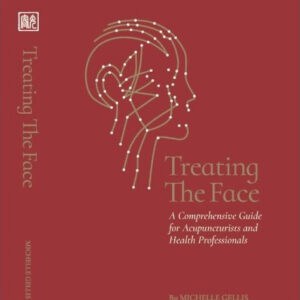Treating the Face: A Comprehensive Guide for Acupuncturists and Health Professionals
Reprinted from the Journal of Chinese Medicine book review by Daniel Maxwell, Issue 137, February 2025, pages 75–76,
To my knowledge this is the first book of its kind. bringing together as it does the yawning gaps between so-called five-element (aka Worsley style) acupuncture, with its focus on the psychoemotional harmony of the patient, with modern acupuncture approaches to cosmetic treatment and facial pathologies, such as motor points, scalp acupuncture and submuscular needling. The author certainly walks her talk in terms of approaching the patient as a continuum of body-mind-spirit, and seems as fascinated by the finer details of anatomy and physiology as she is curious of the most subtle levels of her patients’ inner emotional life, bringing together the exhortation of the Su Wen to ‘first treat the spirit’ with the most pragmatic and earth-bound of technical acupuncture knowledge.
It is a fine looking book, beautifully bound and illuminated in full colour. The extensive use of images – from original drawings of the channels and points through cross-sectional anatomical representations and photos from cadaver dissection – collate an impressive repository of visual information that will be useful for any practitioner wishing to treat the face. The five-element content is extensive, and the author emphasises the unique importance of the face – both diagnostically and for needling – when the focus is the emotional, mental and spiritual aspects of a human being. Diagnostically this focus is greatly assisted by the chapter ‘Anatomy of Expression’, in which the author takes the optimal observational acuity aspired to by five- element practitioners to new levels of breadth and clarity, not only to improve readers’ ability to perceive the movements of qi that ripple across their patients’ faces, but also so that they understand the precise muscles involved in each emotion.
At the heart of the book is the author’s specialist subject of cosmetic acupuncture, and in this section her knowledge and skill shines brightly. There is a deep dive into all the anatomical components of the face – skin, fat, muscle, fascia and bone, and the typical complaints of cosmetic acupuncture patients – wrinkles, sags and lines – are presented in detail through prose and image. This masterclass in cosmetic acupuncture shows just how much knowledge and expertise goes into such treatment. The reader is provided with everything they need to practise this type of acupuncture, such as clear treatment protocols and even marketing and pricing advice. I particularly appreciated the clarity with which needling techniques are described and shown through photos, as well as the sections on how the practitioner should understand and work alongside the orthodox cosmetic treatments that many patients may be undergoing alongside acupuncture (such as chemical peels or fillers). Beyond general cosmetic treatment, the text goes into the treatment of specific cosmetic conditions such as acne, dry skin or vitiligo, and also common neuromuscular facial pathologies such as Bell’s palsy, trigeminal neuralgia or synkinesis. One minor gripe is that the amount of content given to some conditions seems far too brief; for example, at less than two pages, the section on stroke may have been better left to more dedicated texts.
Perhaps my favourite parts of the book were the sections on scalp acupuncture, motor points and submuscular needling. These sections constitute an extremely pragmatic and empowering introduction to these methods. There is enough detail to orientate more experienced practitioners to get started, although I suspect novices would need to attend in-person classes to safely attempt such techniques. The authorial voice is of a seasoned practitioner who wishes to share her hard-won clinical experience, for example that scalp acupuncture can be uncomfortable, even when applied by a skilled practitioner, and therefore one can needle points like auricular Shenmen before treating the scalp. The chapters that follow on the practical aspects of facial cupping, guasha, microneedling and red light therapy are very welcome. Like much of the material in this text, their value lies in the reader’s confidence that the material has been properly understood, clinically validated and clearly transmitted, all in the interests of making readers more effective in clinic.
This book is an eclectic mix, drawn as it is from the author’s many years of treating the face. In this eclecticism it mirrors the variety of life in clinic, and will just as much help a practitioner to relieve the pain of someone with trigeminal neuralgia as it will to help them lift the flesh and spirits of an ageing beauty. The material is bound together by the author’s intent to provide ‘more than just a technical guide; it is an invitation to deepen your understanding of the face as a reflection of the whole person.’ In this job it is entirely successful, and for that the author should be congratulated. It constitutes a significant repository of clinically useful information, all presented in a context that acknowledges the importance of both the interior world of the human being as well as their exterior beauty and physical functionality. I have no hesitation in commending this book it to the profession.

